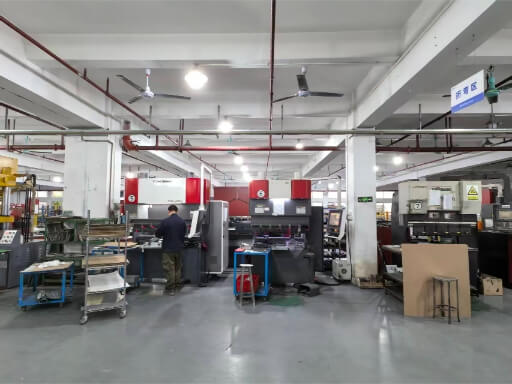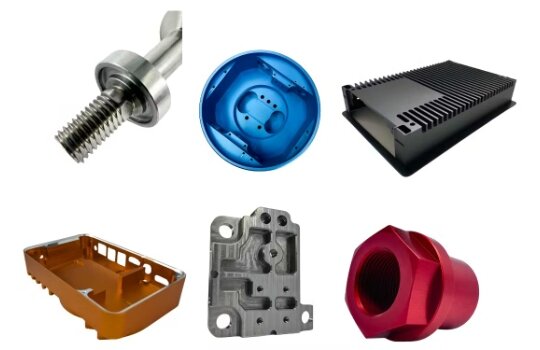A flawless powder coat does not begin in the spray booth. It starts in the CAD model. Powder coating provides parts with a strong, corrosion-resistant finish that has a clean appearance. It creates a thicker and more even layer than liquid paint and holds up well against scratches, chips, and UV light.
The final result depends on good design choices. Even a thin coating can change how parts fit or move. Engineers avoid problems by planning for coating early. They adjust geometry, material, and tolerances before fabrication begins. This guide demonstrates how careful design ensures that every powder-coated part fits well, looks clean, and lasts longer in real-world use.

Why Design for Powder Coating from the Start?
Designing with the coating process in mind prevents costly fit issues later. The following points demonstrate how early planning enhances precision, consistency, and long-term durability.
The Impact of Coating Thickness
Powder coating adds thickness to every coated surface. Most coatings measure around 0.003–0.004 inches per side (approximately 75–100 μm, as per ISO 2360). A slot that starts at 0.25″ can shrink to about 0.242″ after coating. Without enough clearance, the part may bind, misalign, or scratch during assembly.
Engineers can prevent this by modeling coating thickness in CAD or by adding extra clearance at key joints. These small steps remove rework and protect both performance and appearance.
Preventing Rework and Fit Issues
If coating buildup is not planned, technicians may need to sand or scrape parts to ensure they fit correctly. This damages the finish and increases the cost. Better results are achieved by setting precise tolerances and defining no-coat areas in the design. Rounded corners and even radii help powder flow smoothly, reducing defects during curing.
Improving Surface Quality
Sharp edges attract more powder because the electric field concentrates at the corners. This leads to a thick coating with weaker adhesion. A minimum edge radius of 0.015 inches ensures the coating remains even and stronger. Smooth transitions also help the powder settle into a uniform layer, reducing issues such as orange peel or burn marks.
Takeaway: Planning for coating thickness enhances accuracy, reduces rework, and improves surface quality.
Material and Thickness Selection
Material choice affects how powder adheres, cures, and protects. The following sections explain which metals perform best and how to avoid heat-related distortion.
Choosing the Right Base Metal
Metals respond to powder coating in different ways. Mild steel bonds well and is affordable, but it requires treatment to prevent rust beneath the coating. Stainless steel resists corrosion, but its smooth surface can reduce adhesion, so light blasting helps. Aluminum alloys, such as 5052 and 6061, are commonly used for enclosures but require degreasing and conversion coating before use.
A slightly matte surface improves adhesion because it allows the powder to grip more effectively. Highly polished surfaces can reflect heat during curing, which can cause the coating to soften.
| 소재 | 전처리 | Coating Adhesion | 내열성 | 일반적인 사용 |
|---|---|---|---|---|
| 온화한 강철 | Zinc/Phosphate | 훌륭한 | 높은 | Frames, panels |
| 스테인레스 스틸 | Light blast | 보통의 | 높은 | Decorative parts |
| Aluminum 5052/6061 | Conversion coat | 좋은 | 보통의 | Enclosures, housings |
Managing Heat and Sheet Thickness
Powder coating cures at temperatures ranging from 160 °C to 220 °C. Thin sheet metal may warp if it is not supported well. Ribs, flanges, or stiffeners help keep the shape during heating. Hanging holes should stay balanced so that parts expand evenly in the oven.
Mixed-material assemblies require extra care. Aluminum and steel expand at different rates, which can cause stress or gaps to form between them. Separate curing stages or matching alloys can reduce distortion.
Takeaway: The right metal, thickness, and support features keep parts stable and accurate after heat curing.
Dimensional Planning and Fit After Coating
Even a thin powder layer changes part dimensions. Here’s how to manage buildup, clearance, and edge quality for smooth 집회 and lasting performance.
Accounting for Coating Build-Up
Coating is often even on open surfaces, but thinner inside tight areas. For holes, slots, and tabs, adding 0.010″–0.015″ of extra clearance helps the assembly stay smooth. If 프레스 핏 are required, mask contact surfaces or assemble them before coating.
| 특징 | Before Coating | After Coating | Recommended Adjustment |
|---|---|---|---|
| Hole Ø | 0.250″ | 0.242″ | +0.010″ |
| Slot Width | 0.500″ | 0.492″ | +0.015″ |
| 가장자리 반경 | 0.005″ | — | ≥ 0.015″ |
Maintaining Critical Surfaces and Edges
Edges and contact areas need close attention. Thick corners can peel under load, and coated threads can jam. Grounding pads, sliding faces, or electrical contacts must stay uncoated. Clear notes on drawings help the shop avoid mistakes.
예시: A 2 mm aluminum bracket needed an extra 0.012″ on its tab fit. This small change removed all manual filing and saved about 15 minutes per batch.
Takeaway: Small dimension changes solve big assembly problems.
Hardware, Threads, and Fasteners
Threads, inserts, and tight fits react differently to heat and varying coating thicknesses. Let’s examine how innovative design ensures assemblies remain functional and clean after completion.
Protecting Threads and Tight Fits
Threads should stay uncoated. Masking plugs and caps keep them clean. If powder enters a threaded hole, post-tapping after curing removes it. When using inserts or PEM nuts, it is best to install them after coating, as curing temperatures can cause them to weaken.
If hardware must be installed early, choose high-temperature types and ensure proper grounding to prevent powder from accumulating around the 패스너.
Design for Assembly
Coating changes thickness and friction, so joints should have extra space to accommodate this change. Masking lines should be clear on drawings. Welding and riveting should occur before coating, as heat applied later can damage the finish.
Tools also need space. Powder-coated parts scratch easily, so ensure that wrenches or clamps have sufficient clearance to prevent damage.
Takeaway: Good planning protects hardware and ensures a clean final finish.
Hanging, Masking, and Handling in the Coating Process
Coating success depends on how a part hangs, moves, and stays protected. The following tips demonstrate how to simplify setup while ensuring complete and uniform coverage.
Designing for Easy Hanging
Parts must hang during the coating and curing process. If the part is not balanced, it will move and may leave marks on the surface. Adding hanging holes or tabs (≥ 0.063″) in hidden areas can be helpful. Symmetrical holes keep parts steady and support even airflow.
Using the same hanging features across a product line makes loading faster and improves consistency.
Masking Zones and Critical Features
Some areas should remain bare metal. These include ground points, sliding surfaces, and bearing seats. High-temp tape, silicone caps, or laser-cut masks help protect these zones. Natural mask lines, such as flanges or recessed areas, reduce manual work and increase repeatability.
Takeaway: Good hanging and masking design saves time and prevents coating flaws.

Surface Preparation and Coating Specification
Strong adhesion starts with clean metal and clear instructions. Below are key preparation methods and documentation details that guarantee reliable, repeatable coating quality.
Pre-Treatment Matters
Strong adhesion requires clean metal. Oil, dust, or oxidation will weaken the coating. Common steps include degreasing, rinsing, and chemical or mechanical treatment. Steel often uses phosphate or chromate coating, whereas aluminum requires alkaline cleaning and a conversion film.
Specifying Color, Texture, and Gloss
Drawings should list color (with RAL code), texture, gloss, and film thickness. Gloss ranges include matte (30%), semi-gloss (60%), and full gloss (90%). Texture affects appearance and scratch resistance. Fine textures hide fingerprints, while smooth surfaces reflect more light.
Clear notes avoid rework. A good coating note includes:
- Powder color and type
- Gloss level
- Film thickness (example: 80 ± 10 μm)
- Pre-treatment process
- Masking and no-coat areas
Discussing your coating partner’s needs early helps ensure consistency and avoid delays.
Takeaway: Detailed notes remove guesswork and improve quality.
Process Integration and Production Efficiency
Once the design is finalized, production flow determines cost and consistency. These strategies help integrate coating into automated or batch manufacturing with minimal delays.
Designing for Automated or Batch Coating Lines
Part geometry affects loading speed and oven performance. Consistent holes, balanced shapes, and repeatable hanging points improve airflow and curing. These steps reduce variation in color and texture.
Reducing Masking and Color Change Time
Masking and color changes can slow production. Recessed no-coat areas help avoid tape. When using multiple colors, apply lighter ones first. Choosing standard colors across a product line can reduce changeovers by up to 25%.
Managing Cost and Lead Time
Most coating costs are associated with handling, not the powder itself. Complex masking, small batches, or unstable parts add labor. Group parts by color and define standard finishes to speed production. Simple shapes with good access can cut coating time by 20–30%.
Takeaway: Designing with coating in mind lowers cost and keeps schedules on track.
결론
Designing for powder coating is not only about making parts look better; it’s also about ensuring they perform optimally. It is about building accuracy and predictability into every step. When engineers plan for coating early, the process becomes smooth and reliable, rather than a last-minute problem.
At Shengen, our team combines advanced sheet metal fabrication with skilled surface finishing. We work closely with buyers and engineers to review drawings, refine tolerances, and deliver parts that fit and assemble without extra work.
Upload your CAD files or drawings for a free DFM and coating review. Our engineers will help you improve coating strength, control cost, and speed up production—so every part works as well as it looks.
자주 묻는 질문
Can powder coating handle outdoor exposure?
Yes. With proper pre-treatment and UV-stable powders, coated parts resist corrosion and fading for years. Use marine-grade or polyester powders for outdoor or harsh environments.
How does powder coating affect part dimensions, and how can I specify colors and textures?
Coating adds measurable thickness to every surface. Always update tolerances in CAD models and drawings. Specify color (RAL code), gloss level, and texture to ensure consistent finish and visual quality.
When should I request pre-treatments before powder coating?
Always include pre-treatment for steel and aluminum parts to improve adhesion and corrosion resistance. Typical steps include degreasing, phosphate coating, or chemical conversion before spraying.
Can hardware be added before or after powder coating?
Whenever possible, add fasteners, inserts, or PEM nuts after coating to avoid heat damage during curing. Threads should be masked or post-tapped for clean, functional fits.
안녕하세요, 저는 케빈 리입니다

지난 10년 동안 저는 다양한 형태의 판금 제작에 몰두해 왔으며 다양한 워크숍에서 얻은 경험에서 얻은 멋진 통찰력을 이곳에서 공유했습니다.
연락하세요

케빈 리
저는 레이저 절단, 굽힘, 용접 및 표면 처리 기술을 전문으로 하는 판금 제조 분야에서 10년 이상의 전문 경험을 갖고 있습니다. Shengen의 기술 이사로서 저는 복잡한 제조 문제를 해결하고 각 프로젝트에서 혁신과 품질을 주도하는 데 최선을 다하고 있습니다.



